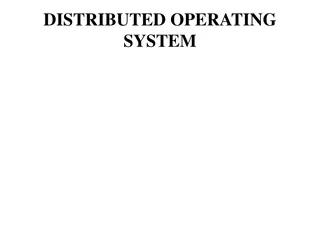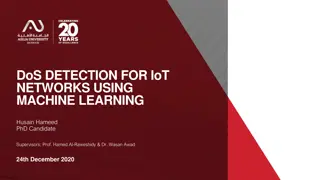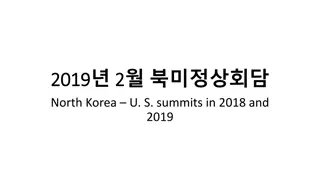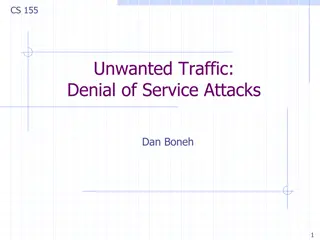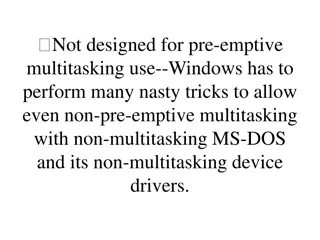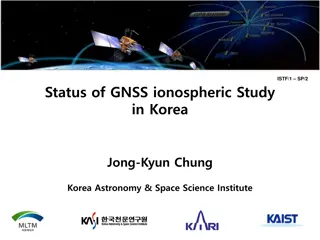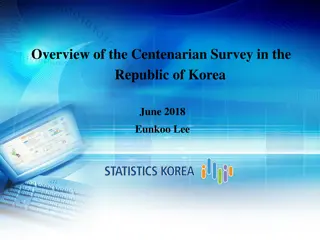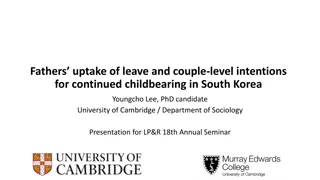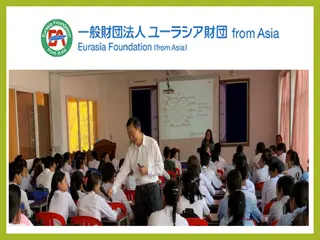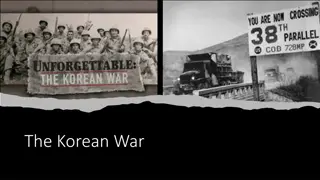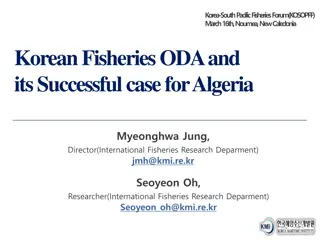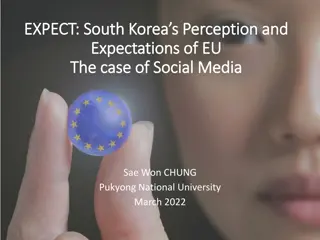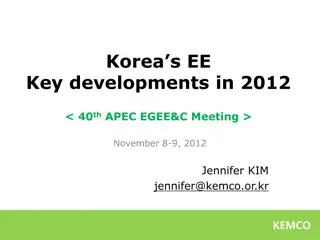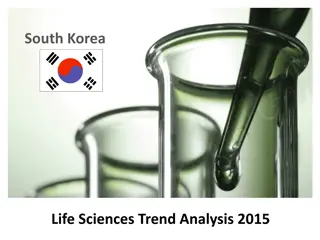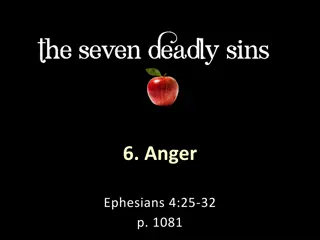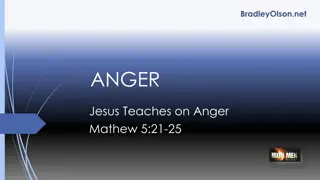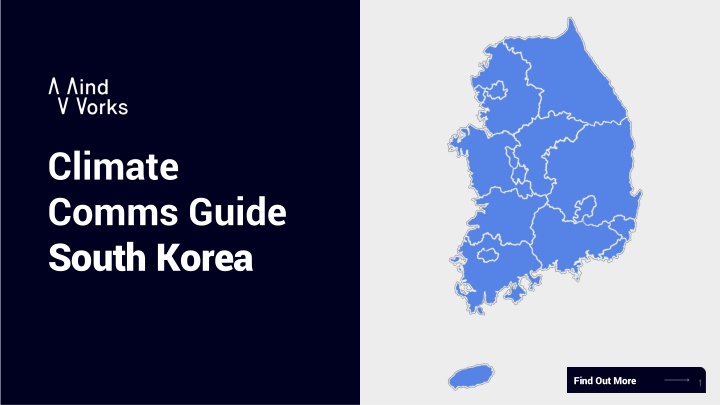
Understanding Climate Communications in South Korea
This guide provides insights on crafting effective climate communication strategies in South Korea by understanding the audience's emotions, beliefs, and cultural context. It highlights the importance of using clear signals, managing optimism levels, embracing anger culture, and building on existing anger to engage effectively with the audience.
Uploaded on | 0 Views
Download Presentation

Please find below an Image/Link to download the presentation.
The content on the website is provided AS IS for your information and personal use only. It may not be sold, licensed, or shared on other websites without obtaining consent from the author. If you encounter any issues during the download, it is possible that the publisher has removed the file from their server.
You are allowed to download the files provided on this website for personal or commercial use, subject to the condition that they are used lawfully. All files are the property of their respective owners.
The content on the website is provided AS IS for your information and personal use only. It may not be sold, licensed, or shared on other websites without obtaining consent from the author.
E N D
Presentation Transcript
Climate Comms Guide South Korea Find Out More 1
www.mindworkslab.org Signal and Noise In all your work, you are contributing to a wider narrative in society. These narratives shift how people think and behave, and in the polycrisis they can change quickly. The strongest narratives are made up of clear and sharp signals. They cut out unnecessary information or noise and are more likely to be received by our audiences. Imagine a lighthouse on the shore: a sailor can use its light to navigate, while a tourist or farmer may just see it as a bright light without understanding its purpose. If the coast were filled with many bright lights, it would be hard for the sailor to know which one to follow and navigate correctly. It's crucial to understand how your audience receives your signals. The Anger and Agency Monitor evaluates people's emotions and beliefs to predict their reactions to specific messages. By using these insights, you can select the most appropriate information and design campaigns effectively to engage your audience. How to use this doc 2
www.mindworkslab.org How to use this document This document contains, country-specific Dos and Don ts based on detailed audience insights from the Anger & Agency Monitor. They allow you to create stories that feel familiar to your audience (confirmation bias) increasing their chance of acceptance. Understanding how your audience will perceive certain information will allow you to design the right signals. If you d be interested in testing some of these insights, don t hesitate to reach out to Mindworks at hello@mindworkslab.org Dos and Don ts 3
www.mindworkslab.org DO Tell people that it will be hard and difficult to manage the transition but it is feasible to overcome the climate challenge as South Korea has overcome other crises in the past. Communicate cautious optimism and grounded hope However, avoid being overly optimistic, as it may not be believable for most people in South Korea. However, also steer clear of excessive pessimism or doomsday language, as this can lead to climate denial or apathy. Find out more here Next 4
www.mindworkslab.org DO Given South Korea s anger culture, your campaigns should aim to make anger more acceptable and support people in accepting their anger as something positive. Don t discourage people from expressing their anger when it has the potential to be constructive. Normalise and support anger expression Anger is best when it is collective and social. Don t encourage individual and isolated expressions of anger, try to ensure it is shared and is combined with increased agency (action with impact). Proactively create opportunities to bring people together who share anger about the same issue. Find out more here Next 5
www.mindworkslab.org DO People are anger saturated and see anger negatively. Introducing new anger or trying to make people blame a new villain will lead to a lot of emotional resistance in South Korea. Build on existing anger and blame Instead, build on causes that people are already angry about, often related to perceived losses. When your story needs a villain, choose one that people already recognize and believe in. This will make your story more believable and introducing a new villain or turning a perceived hero into a villain requires a lot of effort and time. However, be cautious when using blame to mobilize action, as it may discourage people from getting involved. Find out more here Next 6
www.mindworkslab.org DON T Most people have made up their minds on climate change. Educating them more is unlikely to impact their perception; denial isn t ignorance but a defense mechanism. Keep educating people more on climate Instead work on ways to dissolve their denial, for example through meaningfully designed conversations. This is a much more impactful way to shift the balance of climate awareness than information sharing. You can use the most aware members in these conversations to help others. Find out more here Next 7
www.mindworkslab.org DO Focus your communication around your solutions and how they are creating security to make them more valuable for your audience. This can mean that you base your communication on this aspect of your solution or that you specifically look for solutions that create obvious security increases in people s lives, such as climate adaptation. Design solutions that are seen to bring more security Avoid creating uncertainty or ambiguity in your communication, as this can lead to feelings of insecurity. If you need to discuss topics that might cause insecurity, always immediately provide a solution to restore a sense of security, ideally one that your audience can implement themselves. Find out more here Next 8
www.mindworkslab.org DON T Actions that do not deliver impact people can see or experience increases their feelings of powerlessness. Instead focus on solutions and opportunities to raise people s sense of power through actions that have an impact people can see. Give people actions without impact Actions around climate adaptation offer much stronger opportunities to do this, for example organising community based adaptation projects to extreme weather events. These are win-win as they not only build lived experiences of success and impact but also increasing collective resilience and a greater sense of increased security. Find out more here Next 9
www.mindworkslab.org DON T While climate justice campaigns can emphasize fairness and holding culprits legally accountable, as legal action help establish liability norms. However, our results suggest that in South Korea, it may be challenging to build empathy for distant, vulnerable communities. Focus on climate justice narratives Equally, trying to make people help or cooperate with outgroups (those perceived as different or outside their social group) is difficult in South Korea. Therefore try to grow and connect the strength of existing in groups (groups people already by stressing similarities and connections. Find out more here Next 10
www.mindworkslab.org The Glossary Anger Types Anger is not a one dimension emotion, it can be broken down into different anger types such as Constructive, Toxic or restrained. This determines if the anger can be used to drive social change (Constructive) or is more likely to be violent, vengeful and dangerous (Toxic). Agency Agency is the sense of control you feel over your actions, and the capacity to influence your own life (personal agency) or that of your political context (political agency). Agency can only be achieved when people can take action and see the impact it has. Actions without impact leads to powerlessness. Climate Denial We use a broad definition of climate denial that includes partial denial such as believing that climate change is exaggerated or that personal action is pointless. It also includes optimistic denial , for example those who believe that we will adapt or that technology will fix things . These types of denial can act as barriers to collective action and we need to find ways to dissolve them. Signal and Noise "Signal or noise" emphasises focusing on core, impactful messages (signal) that align with key objectives while cutting through irrelevant or distracting information (noise). This distinction ensures communication is clear and resonates with the target audience, avoiding confusion and distraction that dilute the message. Scarcity Mindset One of the key narrative shifts in the polycrisis is from abundance (we all grow rich together) to scarcity (there are limited resources to go around). Depending on your audience s values scarcity narratives could either be built around competition (every person for themselves) or collectivism (we share what little we have). 11
www.mindworkslab.org Want to know more? You can explore the deeper reasoning behind these Dos and Don ts below as well as explore all the data from the Anger & Agency Monitor in the country report. If you d be interested in testing some of these insights don t hesitate to reach out to Mindworks at hello@mindworkslab.org Download this document as a PDF 12

